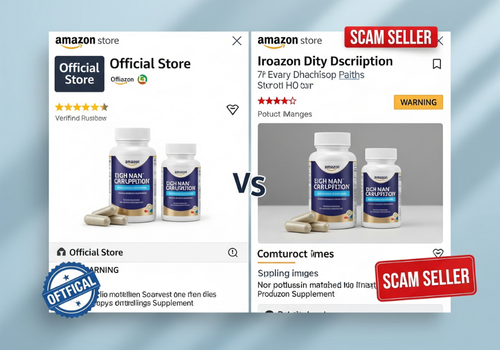Is That Deal Real or a Scam? How to Identify Fake Amazon Sellers and Get to Know Counterfeit Products in 2025
The Rise of Scam Sellers on Amazon in 2025
As Amazon continues to grow, so do the number of third-party sellers on the platform — and unfortunately, not all of them play by the rules. Scam sellers create fake storefronts, hijack legitimate listings, or advertise counterfeit products that closely resemble the real thing. Many operate overseas and vanish overnight once they’ve made enough fraudulent sales, leaving consumers with no refunds and useless goods. In some cases, these sellers hack inactive seller accounts and list high-ticket items at rock-bottom prices to attract fast sales before disappearing. The increase in AI-generated content has also allowed scammers to build convincing product pages that appear completely legitimate — until the product arrives.
How Fake Sellers Trick Amazon’s System
Scam sellers use multiple strategies to bypass Amazon’s security measures. Some create multiple seller accounts under different names using fake business registrations and overseas addresses. Others exploit loopholes in Amazon’s automated systems to list products in restricted categories without proper approval. Many use stolen product images, fake brand names, or copy real product descriptions to pass off low-quality or completely unrelated items. These sellers often have newly created profiles with limited feedback and offer prices that undercut competitors by huge margins. While Amazon has systems in place to detect fraudulent activity, it often takes time for these accounts to be shut down — and by then, it’s too late for the buyer.
Spotting a Scam Seller Before You Buy
To avoid fake Amazon sellers in 2025, check the “Sold by” section under the product title. Reputable sellers often have store names that match the brand, a long selling history, and thousands of verified reviews. If the seller name seems random, new, or includes strange characters, it’s a red flag. Click on the seller’s storefront and review their profile — if they have only one or two listings, no store logo, or zero customer reviews, be very cautious. Always check the seller’s feedback score and the number of ratings in the last 30, 60, and 90 days. Scam accounts often have little to no seller feedback, even if the product has many reviews.
Understanding Counterfeit Products on Amazon
Counterfeit products are fake replicas of real items, designed to look as close to the original as possible — but often fall short in quality, safety, and durability. From supplements and cosmetics to electronics and fashion, counterfeit goods can pose real risks. In 2025, counterfeiters are more sophisticated than ever. They replicate packaging, logos, and even fake barcodes to trick consumers and pass through Amazon’s basic checks. These items often originate from unauthorized factories and have not passed safety or compliance tests. Counterfeit supplements, for instance, may contain banned ingredients, incorrect dosages, or none of the advertised ingredients at all — putting your health in danger.
How to Check If a Product Is Counterfeit
Start by carefully examining product images and descriptions. Look for discrepancies between the listing and what you know about the real brand — such as misspelled words, inconsistent branding, or vague ingredient lists. Check the reviews for complaints about the product being different from what was expected, damaged, or suspiciously ineffective. A spike in negative reviews mentioning the word “fake,” “counterfeit,” or “scam” is a major warning sign. If the product is drastically cheaper than every other listing for the same item, it may be too good to be true. Always buy from Amazon itself or authorized brand storefronts when purchasing high-risk items like supplements, electronics, or personal care products.
Avoiding Suspiciously Cheap Deals and Limited-Time Offers
Scammers often lure buyers in with rock-bottom prices and “limited-time” deals that create urgency. If you find a popular product listed at 50–70% below its normal price from an unknown seller, take a step back. Check if Amazon itself sells the product or if it’s available from an official store at a consistent price. Counterfeit sellers use urgency tactics — like countdown timers, “only 3 left” warnings, or fake sales events — to get shoppers to act without thinking. Resist the impulse to buy fast and instead take time to verify the seller and product details.
Beware of Hijacked Listings and Fake Brand Pages
Hijacked listings are one of the most dangerous tricks used by fake sellers. They take over a legitimate listing — often for a top-selling product — and change the images, title, or details without altering the product reviews. This creates the illusion that the scam product is well-rated. Similarly, fake brand pages are built to mimic well-known companies, using stolen logos and imagery. Always verify brand names, check for “Ships from and sold by Amazon”, and confirm that the product’s reviews match what you’re actually buying. If the reviews mention completely different products, you’re likely on a hijacked listing.
How to Report a Fake Seller or Counterfeit Product
If you suspect a scam, report it directly to Amazon through the product page by clicking on “Report incorrect product information” or visiting Amazon’s Report a Violation page. Provide clear details about the seller, listing, and your experience. Amazon takes reports seriously and may investigate and remove the listing if it violates policy. Additionally, always leave an honest review describing what happened to warn other buyers. You can also contact the brand directly to report the counterfeit — many companies track unauthorized sellers and take legal action when possible.
What to Do If You Fall Victim to a Scam
If you’ve purchased from a fake seller or received a counterfeit item, act fast. Immediately file a return or refund request through Your Orders > Problem with Order. Use Amazon’s A-to-Z Guarantee to escalate the claim if the seller doesn’t respond. Document everything — take photos, keep packaging, and note seller communication. If you paid with a credit card and Amazon doesn’t resolve the issue, contact your card issuer to dispute the charge. Leaving a review warning others is one of the most helpful things you can do after being scammed.
Conclusion: Stay Alert and Shop Smart on Amazon in 2025
While Amazon remains a convenient platform for millions of daily purchases, it’s also a hotspot for fake sellers and counterfeit products in 2025. As a buyer, your best defense is awareness. Always double-check seller profiles, verify product authenticity, and be cautious of deals that seem too good to be true. Use tools like Fakespot to assess review integrity, only purchase from reputable stores or directly from Amazon, and know your rights when something goes wrong. Whether you’re buying supplements, electronics, or gifts, staying informed and skeptical will save you time, money, and frustration. Scammers rely on your trust — but now you have the knowledge to see through the scam.

